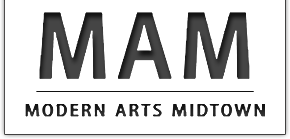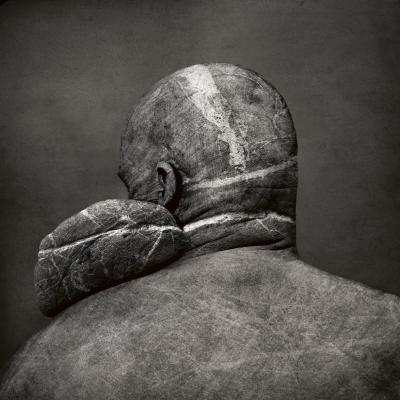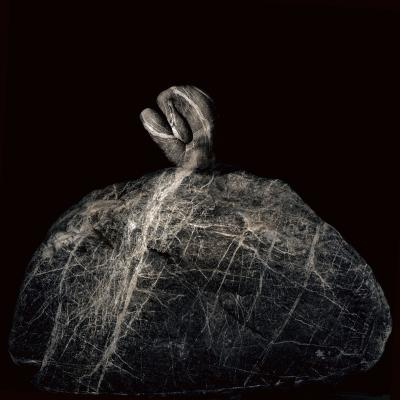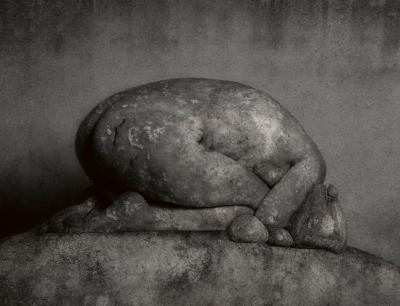About the Exhibition
Roberto Kusterle: Stone Marks
by Michael J. Krainak
Italian photo artist Roberto Kusterle returns to Omaha with a new exhibit, Stone Marks, at Modern Arts Midtown in September, which also includes complimentary work from Fulvio de Pellegrin, Theresa Pfarr and Todd Brown, among others. Presented concurrently at the Garden of the Zodiac in the Old Market Passageway by the Moving Gallery is the exhibition, The Marks of the Metembiosi, alongside fellow photographer, de Pellegrin with his own series, Singular Thinking.
Kusterle originally left his “mark” in the region in 2011 with a Modern Arts exhibit in Lincoln that offered two additional series, Without Time and Place and A Silent Mutation, first seen by MAM director Larry Roots at the Moving Gallery that year. Roots appreciates Kusterle’s art, its visual impact as well as its challenges and point of view, and he explains why in a brief interview below. Regardless of which series, Kusterle goes to incredible trouble in creating surreal scenarios and hybrid realities, first in an elaborate staging process and then in print whether analog or digital. The results are sublime, enigmatic portraits and narratives that transcend ordinary notions of being “one with nature.” In Stone Marks, each image illustrates a dramatic mutation of classical human forms that aren’t merely encased in what appears to be clay, marble or granite. They have become stone, the transformation complete.
Further, in works such as “Listening to the balance,” “The taste of balance” and “Inside the cloud,” each frozen figure enjoys a symbiotic relationship with additional various stones that appear to have emerged from the subject rather than merely attached. Thus, each mythical figure in this statuary of 19 images resembles a preternatural marvel whose beauty defies conventional wisdom and response. No matter how we respond to Kusterle’s imagery, he has left his mark, his aesthetic on us as well. Are we looking at photography or sculpture in Stone Marks? What is real, what is imagined? Not satisfied to photograph an illusion, Kusterle creates them as well. We may never look at either medium the same way again.
Q: How does “Stone Marks” reflect MAM’s overall mission as a Metro gallery?
A: Not only does it reflect our commitment to showing remarkable, distinctive voices locally, it’s a great opportunity to collaborate with the Mercer’s Moving Gallery in our desire in bringing international talent to the Omaha art scene. It is also our mission to represent the ongoing work of each artist. This is our third exhibition of Roberto's evolving work and gives us an opportunity to showcase other figurative artists that compliment his work.
Q: In general, how does this exhibit of Roberto Kusterle’s work differ from his work in “The Marks of Metembiosi” currently on display in the Moving Gallery’s Garden of the Zodiac in the Old Market?
A: I have selected work from the "Stone Mark Series". Simply stated, the images are a dramatic convergence of human and stone. The content is relatively simplified when compared to its concurrent exhibition at The Moving Gallery. Curated by Fulvio de Pellegrin, it is selections from the "The Marks of Metembiosi" which I see as more visceral relationships (interactions) of animal, human and unnatural hybrids.
Q: What interests you as an artist in particular about Kusterle’s photography?
A: I appreciate his unique vision, his staging, his ability to transform subjects that emulate the character of the stone and vice-versa. I like the tactile, textural gravity of his work.
Q: In a previous Moving Gallery show, curator de Pelegrin, also currently in both shows here and at the Garden of the Zodiac, described Kusterle’s art as having “an uncertain harmony.” How is that reflected in “Stone Marks?”
A: There’s an uncertain harmony, yes, because the mystery remains, a combination of simple but startling imagery and complex interpretations. For that, the work is ambiguous. We connect with it beyond an ordinary perception of beauty at some subconscious level, even if we don’t understand it or why.
Q: Unlike past work, it is evident that Kusterle’s current photography utilizes digital manipulation. Why the change do you think?
A: Earlier series had an absolute, mind-boggling attention to staging and installation. He still does this, but sometimes, in order to fulfill your vision you have to extend and adjust your tools. You use what is available in order to grow.
Q: Though Kusterle’s art is figurative and representational, what are the biggest challenges for viewers in appreciating his style and point of view? What are the rewards?
A: It begins with confronting something new and different, I suppose. We immediately reduce our reaction to either ‘I don’t like it” or ‘I do.’ In either case, it requires us to embrace the unfamiliar on its own terms. When we make the effort to see exceptional art, really, the experience is its own reward.





